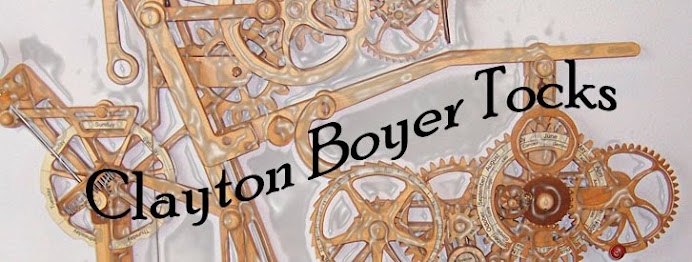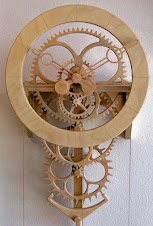Residual internal
friction is the bane of our wooden clock movements. Friction can happen in a variety of places,
and that’s why I always recommend Depthing as we build to help find and
eliminate as much internal friction as possible before the assembly is
completed.
The Depthing process takes
time, but it also saves time at the end in trying to find hidden friction
points. Once the Depthing of all the
pieces is complete, it almost assures that the clock should run well once the
pendulum is put into motion.
Depthing is a simple
process of testing one wheel with its pinion using the clock frame these two
gears will be running in. Depthing is
testing ONE wheel and ONE pinion...not the whole train of gears at one
time.
In reality while
building our clock, we don’t want to just test one wheel and one pinion. We want to test those two gears on their completed
assemblies, just as they will be running in our clock.
We want to first create
a completed wheel arbor assembly (i.e.: wheel, connector and pinion on its
arbor). Then create a second complete wheel arbor assembly. Then
test these two completed arbor assemblies, with their spacers, in the
reassembled clock frame.
I always recommend
Depthing as the clock is being built, however, if the clock has already been
assembled, to depth correctly the clock is taken completely apart. All the arbors removed from the Frame, and
then one wheel assembly and its matching pinion assembly are put back into the
clock. The clock frame is totally
reassembled with just those two arbors, and then the wheel set (one pinion and
one wheel is a wheel set) are tested by gently blowing on the large
wheel. This process will detect even the slightest bit of internal
friction that could stop the clock.
Internal friction may be
caused by the contact surfaces of the wheel and pinion, or possibly the teeth
may be bottoming out in the dedendum (the valley between the teeth), or even a
tight set of spacer tubes could be binding the arbor in the frame. Any and all of these can be detected by
proper Depthing.
Because clocks never run
backwards, only one side of the teeth is ever used. That is called the Contact Side of the
tooth.
If a space is too narrow
between teeth we want to take the wood off of Non-Contact surface of the
teeth. Avoid sanding wood off of the
contact surface of the tooth.
Removing wood from the
back of the toot allows the spacing of the front of the teeth to remain
constant while at the same time opening up the space between the teeth enough
for proper clearance.
A clock wheel travels
only in one direction, and with only one wheel and one pinion in the clock’s
frame it gives us the opportunity to first visualize the direction that the
wheel will be turning in the clock, and to decide which side of the teeth is
the contact side.
With one wheel and one
pinion being tested inside the reassembled frame we are also simultaneously
testing other parts, like the Frame’s arbor holes and the arbor’s spacers, and this
allows us to make sure that these parts are not causing the increased internal
friction.
If the spacers are
causing internal friction they can be filed or sanded slightly to allow freedom
of motion of the two arbors. There
should be about 1/16” (1.5mm) of end play (front to back movement) in each
arbor.
Depthing also can let us
know of another potential cause of internal friction - the arbor holes.
Possibly the arbor holes are binding because the holes in the front and back
frame are not aligned, or because the drill holes are too small or because the
fibers inside the drill hole are going in the wrong direction for that
particular arbor.
Because our drill
presses only turn the drill in one direction as we drill each of the arbor
holes in the frame, that means that every other drill hole has wood fibers
inside the hole that are facing in the opposite direction that the arbor will
be constantly turning as the clock runs. This is usually not a big
problem, but if those opposing directional fibers should get damp and swell they
can easily stop an arbor. Burnishing the inside of the arbor hole can
help in a couple of ways. It can flatten
the wood fibers and also add paraffin to decrease friction. To burnish, simply chuck an arbor rod in a
hand drill, add paraffin to the rod, and run it in and out of the hole. Reverse the direction of the drill and
burnish again.
Then, after that first
wheel set has been tested and the internal friction removed, the clock is then
disassembled again and the first wheel arbor is removed. The next arbor
in the train is then to be tested the same way - one wheel and one pinion -
with their spacers inside the reassembled frame - with a gentle puff of air on
the large wheel.
All of the wheel sets
(one pinion and one wheel) throughout the entire clock are separately tested
using this Depthing procedure. Once the Depthing is complete you can be
sure that the wheels, pinions and spacers are all going to work properly.
Once all the wheels and
pinions are depthed correctly and the clock still occasionally stops, that may
mean that the problem probably is NOT in the wheels or pinions but somewhere
else, such as two parts rubbing causing increased internal friction. This
can happen as an arbor moves forward or back and begins to press its spacer
into the clock's frame with enough force to stop the clock.
You can visually
check. When a clock has been running well and then spontaneously stops
for no apparent reason, check to see if the arbor has moved forward or back and
is rubbing on the frame or some other part. In a clock that is not
properly depthed, this movement of the arbor, combined with the improper Depthing
might create enough internal friction to cause the clock to stop....not from
just one problem, but from the combination of two or more residual problems.
The most common place
for the arbor shifting to happen is at the Center Wheel arbor and its Cap (but
any arbor can shift increasing internal friction). On the Center Wheel
arbor it is usually not the arbor itself shifting that is causing the friction,
but the minute and hour tubes that have slid forward into the Cap.
A common cause of
shifting arbors is mounting the clock to a wall that is not plumb. If your arbors are shifting, check the plumb
of the wall. An easy fix for this is to
shim the clock’s frame so that the clock sits level on the wall.
Also, once the clock is
mounted level, another fix that can help minimize shifting arbor friction is to
cut a couple of nylon or Teflon washers to fit between the tubes and the
Cap. These washers will allow the tubes to turn at the Cap, but not rub
on the Cap.
To cut your own washers,
you can use something like a plastic coffee can lid. Drill the plastic with
a brad point bit that is just slightly over-sized for the arbor. I use brad
point bits for these center holes because they give a cleaner cut and don't
leave a ragged plastic edge around the hole. Once the center hole is
drilled, the washer can be cut to size from the lid with scissors or even a
larger brad point bit.
Sometimes internal
friction as slight as the tubes rubbing on caps is enough to stop a clock,
especially if it happens in concert with another source of internal friction.
To minimize internal
friction even more paraffin can be used on the contact surfaces of the teeth,
on the arbor rods, and in the arbor holes in the frame. I prefer using a color coordinated Crayon
because the paraffin of a Crayon is softer than candle wax and the sharp tip
allows us to get the paraffin in between the teeth easily. But not too much! Too much paraffin can pack into the dedendums
(the valleys between the teeth) and cause the teeth to bottom out into the wad
of wax. This bottoming out will stop the
clock.
Another source of
internal friction that has nothing at all to do with the clock’s gear train
could be the groove in the pendulum pivot rod.
Too deep a groove can cause the clock to stop. The groove in the pendulum pivot rod should
be 1/32” (0.75mm) or less in depth. We
want only enough depth to hold the sharp, knife-edge point of the pendulum pivot
from slipping side to side.
The Pendulum/Pallet/Crutch
assembly can be tested for friction by simply removing the Escape Wheel. With the Escape Wheel removed, move the
Pendulum’s Bob to the side about two or three inches and let it go. The Pendulum/Pallet/Crutch assembly should
continue to rock freely for at least 60 seconds, and 90 seconds is even better.
If the Pendulum/Pallet/Crutch
assembly does not rock freely for at least 60 seconds, check all contact points
for friction. Maybe the arbor holes in
the frame are not aligned, or the arbor holes are drilled too small. Or possibly the Crutch Pin slot in the
Pendulum is too tight. The Crutch Pin
should move freely in the Pendulum’s slot, but not with too much slop. Too narrow a slot will cause binding friction
with the Crutch Pin. Too wide a slot
will not allow the Crutch Pin to deliver the impulse to the Pendulum. With loss of this impulse from the Crutch Pin
the clock will stop.
So to summarize, one tests the pinion on the escape assembly
with the third wheel assembly without the center wheel assembly (a with b) and
then the pinion on the third wheel assembly with the center wheel assembly
without the escape assembly (b with c).
With all this done,
then all three (a + b + c) should run freely in the assembled
clock.
Also, the cannon is
tested with the intermediate wheel and then the intermediate wheel is tested
with the hour wheel.
And the pallets are
tested with the escape wheel (see FAQ's for more information on manually testing
the pallets and escape wheel).
And the pendulum is
tested with the crutch assembly of the pallets.
The more Depthing and
testing that is done during assembly the better chance that the clock will
continue to tick with the first gentle push of the pendulum.
Remember also that
changes in humidity can affect these wooden clocks. With high humidity the wood can swell and
stop the clock. In very humid conditions
I simply do nothing. It is best to do
nothing because as the atmospheric conditions change the clock will begin
running well again. The Woodworker’s
Hygrometer is an excellent kinetic sculpture for detecting these changes in
humidity.







